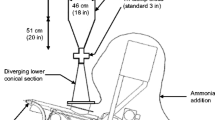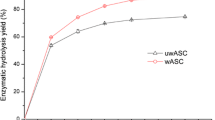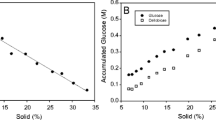Conclusions
The enzymatic digestibility of a pretreated substrate is enhanced by increasing the severity of the pretreatment conditions, apparently because a greater fraction of the hemicellulose sheath surrounding the cellulose is dissolved. This allows the enzyme greater access to the cellulose. However, optimizing enzymatic digestibility will not optimize the production of ethanol. Although increasing the severity of the pretreatment conditions will decrease the remaining xylan, it will also result in the conversion of xylose to furfural. This is a loss of a potential carbon source for conversion to ethanol. The more severe conditions also result in the conversion of more of the cellulose to glucose and subsequent conversion to 5-hydroxymethylfurfural (HMF). Although the digestibility of the pretreated material may be enhanced by the more severe conditions, the conversion of this material to ethanol by yeast may be poor because of the higher levels of furfural and HMF, which are toxic to yeast. The best pretreatment conditions are those that produce the highest ethanol yields, which is influenced by the enzymatic digestibility of the pretreated substrate, the xylose yield, and the production of toxic byproducts.
Similar content being viewed by others
References
Wright, J. D. (1988),Chem. Eng. Prog. 84, No. 8, 62–74.
Shah, R. B., Clausen, E. C., and Gaddy, J. L. (1984),CEP Newsl. Jan., 76–80.
Grohmann, K., Torget, R., and Himmel, M. (1986),Biot. Bioeng. Symp. 17, 135–151.
Torget, R., Himmel, M., Wright, J. D., and Grohmann, K. (1988),Appl. Biochem. Biotech. 17, 98–104.
Clausen, E. and Gaddy, J. L. (1984),Proc. 1984 Ann. Meeting Amer. Solar Energy Soc., 101–105.
Knappert, D., Grethlein, H., and Converse, A. (1980),Biot. Bioeng. 22, 1449–1463.
Wayman, M., Seagrave, C., Parekh, S. R. (1987),Process Biochem. 22, No. 2, 55–59.
Mes-Hartree, M., Hogan, C., Hayes, R. D., and Saddler, J. N. (1983),Biot. Letters 5, No. 2, 101–106.
Harris, J., Baker, A., Conner, A., Jeffries, T., Minor, J., Pettersen, R., Scott, R., Springer, E., Wegner, T., and Zerbe, J. (1985),Two-Stage Dilute Sulfuric Acid Hydrolysis of Wood, General Technical Report FPL-45, US Department of Agriculture, Madison, WI.
Theander, O. (1991),Animal Feed Science and Technology 32, 35–44.
Sitton, O. C., Foutch, G. L., Book, N. L., and Gaddy, J. L. (1979),Proc. Biochem. 14, No. 9, 7–10.
Author information
Authors and Affiliations
Rights and permissions
About this article
Cite this article
Schell, D.J., Walter, P.J. & Johnson, D.K. Dilute sulfuric acid pretreatment of corn stover at high solids concentrations. Appl Biochem Biotechnol 34, 659–665 (1992). https://doi.org/10.1007/BF02920586
Issue Date:
DOI: https://doi.org/10.1007/BF02920586




